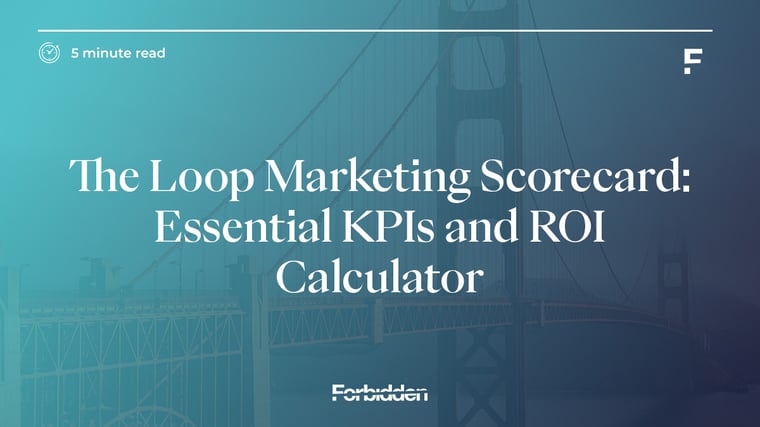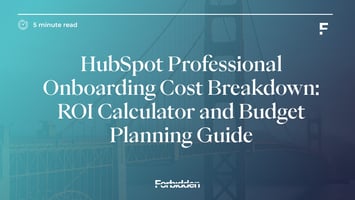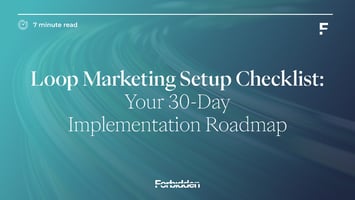The Loop Marketing Scorecard: Essential KPIs and ROI Calculator

Loop Marketing is only as powerful as the data driving it. While HubSpot’s new framework helps teams move faster and smarter, the real magic happens when you can measure the impact of every cycle, from creative velocity to customer lifetime value.
This guide unpacks the essential KPIs that define Loop success, how to benchmark them, and how to build a scorecard that gives you a clear picture of ROI and growth momentum.
If you’re new to the concept, start with our introduction to Loop Marketing or our practical 30-day Loop Marketing setup guide before diving into measurement.

Understanding Loop Marketing Metrics
Traditional Funnel vs. Loop Marketing KPIs
In the traditional marketing funnel, performance is measured linearly - traffic at the top, leads in the middle, conversions at the bottom. But that model doesn’t reflect how modern marketing actually works. The funnel ends; the Loop never does.
Loop Marketing focuses on iteration and evolution, not one-off campaigns. Instead of tracking leads as a simple flow, you measure how quickly and effectively each stage of your Loop (Express, Tailor, Amplify, and Evolve) drives growth and learning.
Where funnels track volume, Loops track velocity and efficiency.
Where funnels end in handover, Loops close with insight and start again.
Four Core Measurement Categories
To make Loop Marketing measurable, every KPI you track should ladder up into one of four key categories. These represent the pillars of performance in a continuous marketing system; covering speed, effectiveness, intelligence, and efficiency.
-
Speed: How fast can your business learn?
Loop Marketing is built on iteration. The faster you can complete a full Loop, from creative concept to campaign learnings, the more adaptive your marketing becomes. Measuring speed isn’t about rushing; it’s about reducing friction in your process.
Track how long it takes to move from Express to Evolve, how quickly assets get to market, and how efficiently insights are turned into next steps. Speed creates momentum and momentum compounds results. -
Conversion: How effectively are you moving people through the Loop?
Each stage of the Loop has its own conversion goal: awareness to engagement, engagement to activation, activation to advocacy. Monitoring stage-specific conversion rates shows where prospects are flowing smoothly, and where your system is leaking.
When conversion rates stall, the data will reveal which stage needs work, not just that something’s underperforming. This gives teams a clear roadmap for optimisation rather than guesswork. -
Intelligence: How well is AI improving your marketing?
In a Loop Marketing model, AI plays a critical role in driving personalisation, audience segmentation, and content optimisation. But not all automation equals intelligence.
This category measures the quality of AI output, how accurately it predicts behaviour, how relevant its recommendations are, and how much lift it creates in engagement and conversions. The smarter your AI systems become, the more your Loops learn and self-optimise. -
Efficiency: How much value are you generating per pound spent?
Efficiency closes the Loop. It ties activity back to commercial impact, tracking ROI, cost per acquisition, and resource utilisation. The aim is to prove that each iteration of your marketing cycle not only performs better creatively but also delivers higher returns with less input.
Efficiency isn’t just about budget control; it’s about building a system that scales intelligently, where every Loop drives measurable business growth.
When you align your metrics across these four categories, you create a clear feedback system that shows not just what happened, but why it happened and how to make it better next time.
Setting Baseline Performance Benchmarks
Before you can measure improvement, you need a clear picture of where your marketing stands today. Establishing a baseline gives you a reference point for every future optimisation, helping you quantify real progress rather than rely on gut feeling. Without it, you can’t prove whether a new campaign, workflow, or AI tool actually made an impact.
Start by running a HubSpot performance audit across your campaigns, content, and revenue data and identify your current numbers for engagement, conversion, and customer acquisition across each Loop stage. This becomes your “Loop Zero.” From here, every iteration should aim to reduce cycle time, improve efficiency, and increase conversion.
Once your data foundations are solid, benchmark performance both internally and externally. Compare your baseline to industry standards using HubSpot’s State of Marketing Report or platforms like Databox to understand how you stack up. This context helps set realistic but ambitious targets and makes it easier to demonstrate the commercial impact of every future Loop. Over time, your baseline becomes more than just a starting point; it’s your proof of evolution, showing how each iteration drives measurable, compounding growth.
Essential Loop Marketing KPIs
Loop Velocity: Journey Speed
Loop Velocity measures how fast your marketing team can move from ideation to iteration, the number of complete Loops executed per month or quarter.
It’s the heartbeat of operational agility. A higher velocity means faster experimentation, quicker learnings, and a shorter path from insight to revenue.
To improve it:
-
Automate repetitive workflows in HubSpot.
-
Use AI to accelerate content production.
-
Reduce internal approval bottlenecks.
If you haven’t yet built your core workflows, our Loop Marketing Setup Checklist outlines a week-by-week roadmap to get you started.
Benchmark: For scaling SMEs, aim to complete 1–2 full Loops per month, with measurable improvement after each cycle.
Stage-Specific Conversion Rates
Each stage of the Loop contributes to movement down the customer journey:
-
Express → Tailor: Are your creative assets resonating enough to warrant personalisation?
-
Tailor → Amplify: Are your audience segments converting across campaigns?
-
Amplify → Evolve: Are those campaigns delivering tangible business impact?
Tracking these conversion rates helps identify where friction occurs. Use HubSpot’s campaign analytics and lifecycle reporting to visualise drop-off points and reallocate effort where it matters most.
Benchmark: Look for consistent lift per stage (5–10%) as your processes mature.
AI Personalisation Effectiveness
Loop Marketing leans heavily on AI, but automation is only as good as its output. AI Personalisation Effectiveness measures how well your algorithms are improving engagement and conversion rates.
Key signals include:
-
CTR and conversion lift from dynamic content vs static.
-
Accuracy of AI-driven audience segmentation.
-
Open rate uplift from AI-optimised subject lines.
HubSpot’s AI analytics and A/B testing tools can isolate AI’s contribution to performance. Over time, aim to benchmark AI-led campaigns as 15–25% more effective than manual equivalents.
Customer Acquisition Cost Optimisation
CAC optimisation measures the balance between marketing spend and new customer acquisition. In a Loop model, CAC should reduce with every iteration - as data sharpens, efficiency improves, and wasted spend declines.
Calculate it monthly and by campaign. If your CAC isn’t trending down, review where spend accumulates across the Loop, often inefficiency hides in the Amplify stage (media cost) or the Evolve stage (slow feedback loops).
Target: Maintain a CAC:LTV ratio of at least 1:3 for sustainable growth.
Advanced Measurement Techniques
Revenue Attribution Across Loop Stages
Attribution in Loop Marketing isn’t about “who gets credit”, it’s about understanding how each stage contributes to revenue.
Set up multi-touch attribution models in HubSpot to capture the full journey. This reveals the relationship between content creation (Express), segmentation (Tailor), activation (Amplify), and feedback (Evolve).
By analysing revenue contribution per stage, you’ll see exactly which tactics drive pipeline efficiency and which slow it down.
If you’re not sure how to configure attribution or reporting correctly, our HubSpot Onboarding team can help you build a scalable analytics infrastructure.
Lifetime Value Impact Analysis
Loop Marketing compounds over time. As personalisation deepens and AI optimises engagement, customer lifetime value (LTV) should naturally rise.
Track metrics like:
-
Repeat purchase rate.
-
Upsell and cross-sell performance.
-
Retention and churn metrics linked to campaign cycles.
Use HubSpot’s Revenue Analytics to connect campaign data to recurring revenue. The goal is to prove that smarter marketing loops directly increase LTV, not just acquisition volume.
Predictive Analytics & Forecasting
Once you’ve gathered enough Loop data, move from descriptive to predictive analytics. HubSpot’s forecasting models and AI recommendations can predict which campaigns, audiences, or channels are most likely to perform.
Integrate these insights into your planning. Use forecasts to set proactive goals for conversion, CAC reduction, and Loop velocity to transform your scorecard from a retrospective report into a forward-looking decision engine.
Competitive Benchmarking
Finally, measure yourself against the market. Use industry data from HubSpot’s State of Marketing Report or tools like Databox and BenchmarkONE to gauge how your Loop performance compares to similar organisations.
Look beyond vanity metrics, focus on operational KPIs like cycle time, conversion lift, and ROI per Loop. The strongest brands aren’t just producing content faster; they’re learning faster.
How to Build Your Loop Marketing Scorecard
Your Loop Marketing Scorecard should give leadership and delivery teams a unified view of progress, both strategic and operational. Here’s what to include:
-
Loop Velocity Tracker: Total Loops completed per month or quarter.
-
Stage Conversion Dashboard: Visualising drop-offs and gains at each phase.
-
AI Performance Index: Showing AI-driven lift in engagement and conversions.
-
CAC & ROI Calculator: Total marketing cost per acquisition, linked to revenue.
-
Continuous Learning Notes: Documenting each iteration’s insights and next steps.
HubSpot’s dashboard tools make this easy to build - just combine campaign analytics, attribution models, and AI reports into a single command centre.
Turning Data into Growth
Loop Marketing isn’t about more data, it’s about better data. The Scorecard turns insights into strategy, helping you focus on the KPIs that actually move the needle.
Measure velocity to move faster. Track conversion to get sharper. Monitor CAC to spend smarter. When your Loop Scorecard becomes your operating system, growth becomes predictable.
To take your measurement even further, download the official HubSpot Loop Marketing Playbook for advanced analytics frameworks, templates, and setup guidance.
To take your measurement even further, download the official HubSpot Loop Marketing Playbook for advanced analytics frameworks, templates, and setup guidance.










